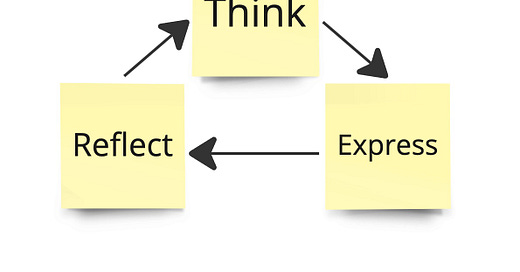Have more focused discussions with visual models
Building visual models and using them for discussion prevents endless monologues and distractions
If you want to explain something complicated, make it visual. Remember when you sat in school, and your teacher drew how cell division works on the board? Part of this information is probably still stuck in your brain years after you saw it.
Usually, we don't talk about biological processes in product work. But we also deal with complicated procedures. One way of having an informed discussion about an intricate topic is to simplify it into a model and start the conversation with this unifying view.
The cell model, your teacher showed you, doesn't show the gory details of biological processes. Still, it gives an overview of a specific process and invites you to ask questions about what's happening. This is the effect you want to have in your discussions. Set a topic and stay on the right level of abstraction without somehow ending up in a heated debate about a tiny detail.
Start by creating a model for your topic. There are two forcing functions playing out when making such a model. First, drawing a model forces you to decompose and clearly articulate the topic. Our minds are always taking shortcuts if we don't prevent it deliberately. We must force ourselves into operating in a think → express → reflect → think loop to ensure we visualize what we think and check if our thinking is conclusive.
The second forcing function — building a model helps you clarify a topic's kernel. You can't add every single tiny detail into your model. It forces you to concentrate and leave a bit of the detail out.
Start with an idea of what the goal of your model is, and write it down. Then get all your thoughts on the topic out and sort them however it feels natural. Maybe time as a factor feels right, perhaps affinity fits more or a hierarchy is the right approach. There are many ways, depending on what you want to express. Create an overview for yourself. Then, reduce to the fundamental aspects and group others together while showing connections and distinctions. There is not a correct way to come up with a model, try and play around until you have something halfway expressing what you want to convey. Don't lose your goal, and don't try to hard to find the perfect solution.
Having this model's first version, you can start walking somebody through it. Check with other people if your mental model aligns with their understanding. See what questions they have.
When you just use words, everything is way too open for interpretation. The communication receiver can quickly grasp your interpretation of a topic by looking at your visual and reflect on it in their head. They can ask you questions about a specific aspect or point out where they think this model is wrong or lacks precision.
The viewer goes through another loop while giving feedback: see → reflect → express → see.
Once you get used to this form of communication, adapt and evolve your model and re-use it. Try several approaches for the same topic to get different perspectives for a more refined understanding.
The model won't answer your challenges, but it helps to have more informed discussions and allows you to concentrate on specific details without getting lost.






